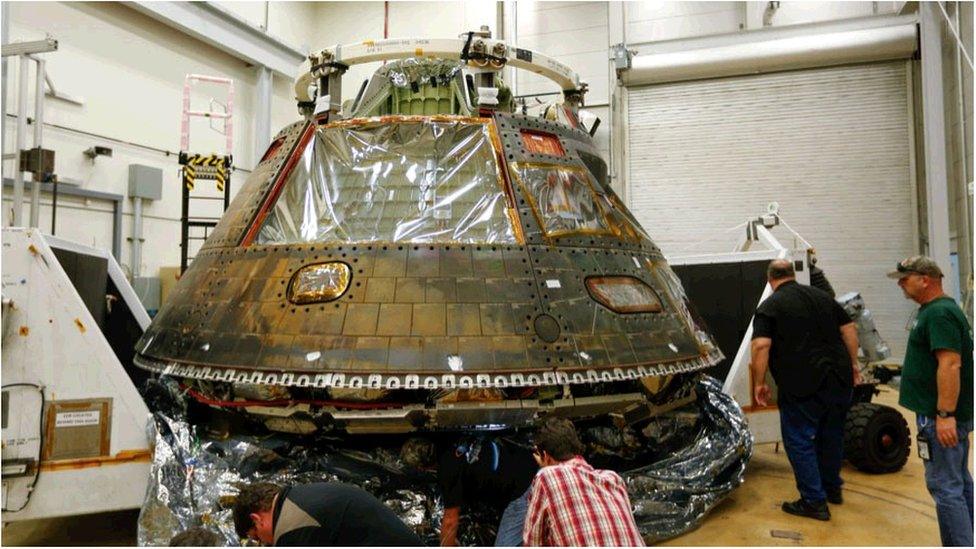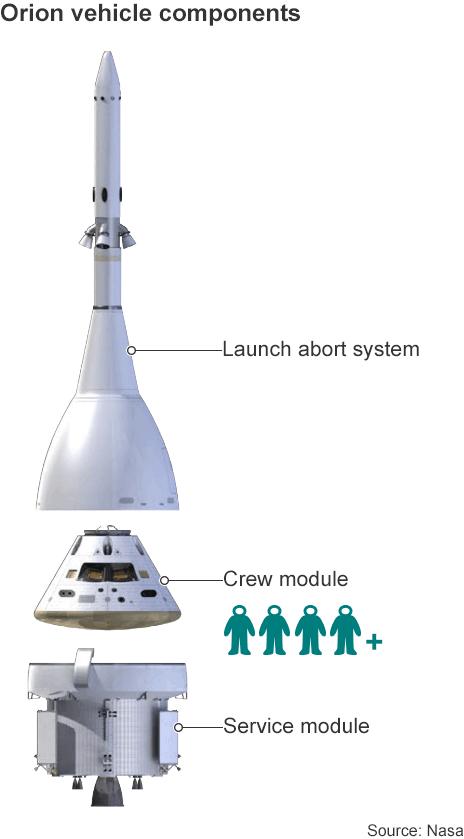Orion astronaut flight faces delay to 2023
- Published

Nasa has already invested billions in the project
The US space agency says its new astronaut capsule may not actually carry people until 2023.
A test flight of Orion with humans aboard had previously been pencilled in for 2021, but officials say they now have less confidence in this date.
Development difficulties "historically pop up", meaning future delays to the programme were a possibility, they told reporters during a teleconference.
An Orion test capsule flew an unmanned mission in December last year.
It was a near-flawless outing, circling a few thousand kilometres above the Earth, but the capsule did not use the rocket for which it has been designed. This is a huge vehicle, also still in development, known as the Space Launch System (SLS).
More powerful than the Apollo programme's Saturn V, the SLS is due to make its debut with Orion - again in an uncrewed configuration - in late 2018.
Only after that will the pair be prepared for a test flight with astronauts, possibly taking them on a trip around the back of the Moon.
Nasa had been working towards a "not before" date of August 2021 for this mission, known as EM-2.
But a review of past progress and an assessment of future challenges has now prompted managers to change the target to a "no later than" April 2023.

The unmanned capsule flown in December 2014 will be used in further test campaigns
They have identified a number hardware and software problems that could disrupt the 2021 timeline.
One is the reliance on the re-use of certain components from one test to another.
If any of these fail and new parts are needed, this has the potential to use up margin in the programme.
"Right now we're not seeing any issues in those areas, but we have to account for those because we've got a lot of runway in front of us before we get there and those things could pop up," said Nasa associate administrator Robert Lightfoot
And Bill Gerstenmaier, who is the agency's senior executive responsible for human spaceflight matters, added: "I think we're being somewhat conservative. My teams will tell you they're trying to work every risk that's out there. Every risk that the Standard Review Board has identified - we think we can handle those risks.
"But if you look at the complexities of what we're doing building this spacecraft, there will be some unknowns that show up, and to protect for those we went with the later date, the 2023."
One uncertainty is the critical contribution being made to the Orion system by the European Space Agency.
This is its service module - the back end of the capsule that pushes it through space.
The module's first use will be on the 2018 unmanned test flight with the SLS.
If there are performance concerns, any re-engineering that is required could impact the EM-2 flight.

Construction has started on the capsule that will be used in the 2018 unmanned flight
Nasa is working to a baseline budget of $6.77bn for Orion, from October 2015 through to the first crewed mission, assuming that is in 2023.
The development cost to date has been $4.7bn, according to Mr Lightfoot, although this number does not include the several billion spent on the capsule concept when it was part of the cancelled Constellation programme. That was President George W Bush's project to go back to the Moon.
And all this money is separate to the sums funding SLS development.
Orion is intended to be a beyond Earth-orbit system. It will have the capability to take astronauts past the space station, to destinations such as the Moon, asteroids and, ultimately, Mars.
This requires, for example, that it have special life-support technologies and hardened electronics to handle the harsher radiation environment of deep space.

Jonathan.Amos-INTERNET@bbc.co.uk, external and follow me on Twitter: @BBCAmos, external